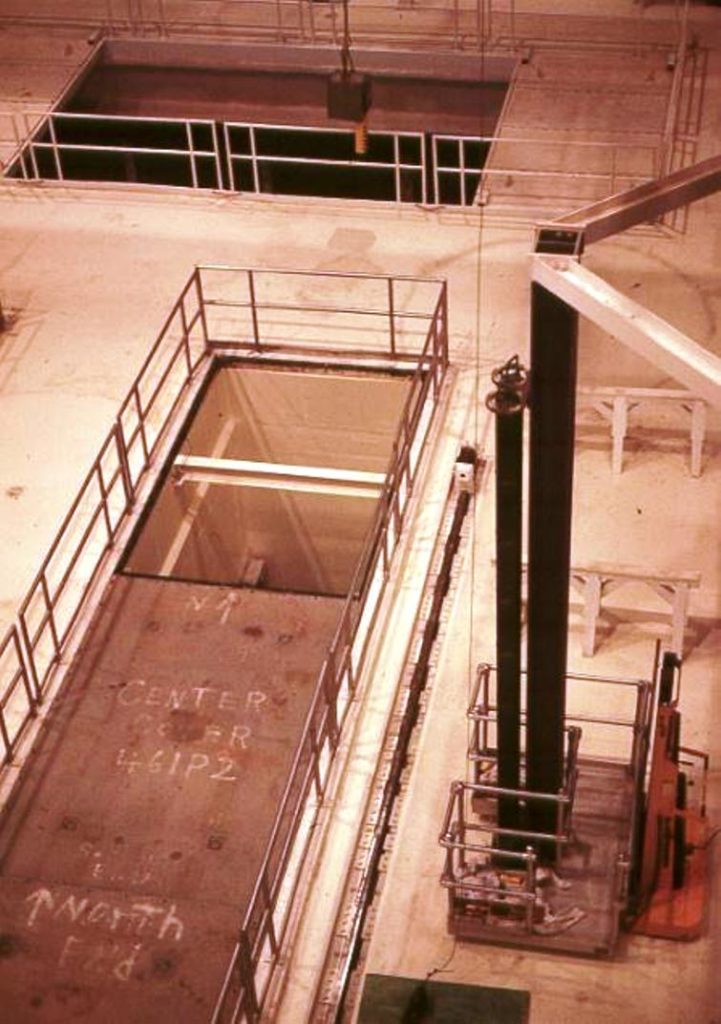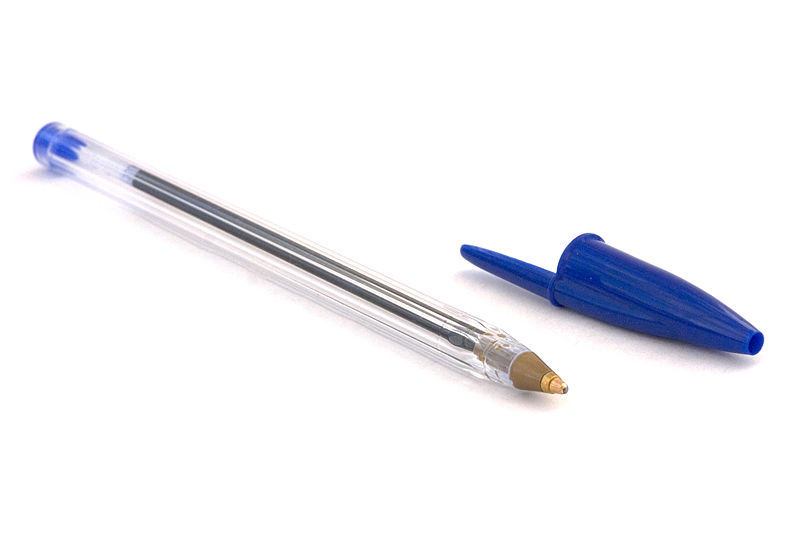Fission Stories #187
The previous Fission Stories commentary described a problem with new nuclear fuel encountered at Browns Ferry in the early 1980s. This commentary sustains that theme by describing another problem with new nuclear fuel, this time at the Grand Gulf Nuclear Station near Port Gibson, Mississippi.
I was the reactor engineering supervisor at Grand Gulf as Unit 1 approached its first refueling outage. Preparations for refueling included getting the new fuel bundles that would replace some of the fuel bundles in the reactor core.
Loading new fuel bundles
The new fuel bundles arrived at Grand Gulf on 18-wheeled trailer trucks packaged two bundles per box. Workers used a crane to lift the boxes one at a time from the truck bay on the ground floor of the auxiliary building vertically to the refueling deck about four floors higher using the opening at the top of the picture. Boxes would be placed on the white support structures (also known as wooden sawhorses) to the right center of the picture, opened, and unloaded.
One at a time, the new fuel bundles would be moved using the overhead crane into the fuel inspection platform. A dummy fuel bundle is loaded into the fuel inspection platform in the picture. Workers raise and lower the platform while inspecting the new fuel bundle. Upon passing inspection, a new fuel bundle is placed in storage racks inside the new fuel vault (the rectangular thing extending from the lower left corner to the upper center of the picture). The spent fuel pool is not shown in this picture but is located off to the left.
Because new fuel bundles do not generate decay heat as do spent fuel bundles, they can be air-cooled in the new fuel vault. The new fuel vault has covers to protect the valuable new fuel bundles from damaged caused by debris falling on top of them. One of the new fuel vault covers is removed in the picture.
Many workers are involved in receiving and inspecting new fuel bundles. Craft workers operate the overhead cranes used to move boxes and individual fuel bundles. Other craft workers open the boxes and remove protective wrapping inside the boxes. Health physics technicians monitor radiation levels even at the extremely low levels from new fuel bundles. Reactor engineers and quality control inspectors verify that the new fuel bundles meet design specifications and are undamaged.
A fly in the ointment
All of these tasks are performed according to procedures. And completion of each task is documented by at least one individual signing off that step in the procedure. After all the new fuel bundles in the shipment had been unloaded, inspected, and placed into the new fuel vault, a worker leaned over the railing around the vault to look down at the fuel. A disposable ballpoint pen in his shirt pocket fell into the vault. According to several witnesses, it fell down a space between the storage racks and the wall, hit the floor, and disappeared from view.
None of the procedures at the time contained a section describing how to retrieve a dropped pen from the new fuel vault. So, the reactor engineer on the refueling floor at the time directed that the covers be reinstalled over the vault. He also wrote (it was not his pen at the bottom of the vault) a corrective action report about the misplaced pen.
The safety concern was that the pen might have fallen into a new fuel bundle and get carried with it into the reactor core. The pen might partially block cooling water flow for some of the fuel rods in that bundle or cause other mayhem.
The pen is mightier…
The corrective action report imposed a restriction that no fuel bundle could be removed from the new fuel vault until either the pen was retrieved or an analysis was completed showing that the pen could cause no damage even if present in a fuel bundle loaded into the reactor core.
Having experienced inspecting fuel bundles for foreign objects, I was not anxious to replicate this effort. So, I asked the Nuclear Fuels group to evaluate the possible harm from a pen potentially inside a fuel bundle potentially loaded into the core of an operating reactor. Their conclusions were mostly good. The ink would be so diluted as to pose no harm. The plastic pen casing and end caps would melt at the reactor’s normal operating temperature and pose no harm.
But the metal tip of the pen could cause trouble. While not large enough to block cooling water flow, it was large enough to damage fuel rod cladding by impact as the cooling water flow banged it around inside a fuel bundle.
Their bottom line: the pen had to be retrieved before any fuel bundle was removed from the new fuel vault.
As reactor engineering supervisor, I exercised command authority and volunteered to venture into the vault to recover the pen. I thought it would be a simple task. The bottom of the storage racks are three to four inches above the floor of the new fuel vault, supported by metal feet at the ends and occasional midpoints. This configuration promotes air flow through the fuel bundles since the racks are open at top and bottom. I planned taking a flashlight into the vault with me and using it to shine underneath the racks. The pen would readily stick out on the bare floor. The only complication might be if it had ricocheted off a wall and rolled too far under the rack for me to reach. My contingency plan was to have a broom handle lowered down to me to extend my reach.
The hunt
The cover was removed from the end of the new fuel vault and a ladder lowered into it. I climbed down the ladder into the vault supremely confident that I would emerge holding a disposal ballpoint pen in my hand. (I had stacked the deck by having such a pen in my back pocket when I entered the vault. I was emerging from the vault with a pen, one way or other.)
I got off the ladder, knelt down on the vault’s floor, and shined the flashlight underneath. No pen. Nothing rested on the floor between me and the wall on the far side of the rack.
I stood up to think. The pen could not be inside a fuel bundle. Fuel bundles for boiling water reactors like Grand Gulf are encased in hollow, metal, rectangular boxes called channels. The pen was seen by several individuals to fall into the vault and hit the floor. The only way for the pen to get inside a fuel bundle was through the bottom inlet nozzle. But the nozzles were mere inches off the vault’s floor and a pen would have to bend and twist around to enter a nozzle.
I got back down onto my knees to peer under the rack again. The pen had to be on the floor, but it was not there.
I stood up to think some more. As I debated whether to try a third look under the rack or to pull the pen from my back pocket, I noticed something odd about the rack. The metal racks were made from steel. The bottom edge was made from 90-degree angle iron with one vertical side and one horizontal side. Lying on the horizontal edge of the bottom brace against the vertical part was the mystery pen. I retrieved it and climbed up the ladder.
Word that the hold point preventing fuel bundles from being transferred out of the new fuel vault had been eliminated spread quickly through the plant. People began dropping by my office to confirm the news and congratulate me on getting past this obstacle. The assistant plant manager asked if he could keep the pen as a souvenir. I handed it to him. While we were still talking, one of the General Electric site representatives stopped by. He also asked for the pen as a souvenir. I reached into my desk drawer and handed him a pen. In short order, I had four or five people in my office each holding a souvenir pen.
Our Takeaway
I don’t know if I’d have emerged from the vault with the fake pen from my back pocket had I not found the missing pen. I’d like to think I would not have faked its recovery, but I’m not so sure. I’d experienced not finding larger pieces of metal that could pose greater harm to fuel bundles than a ballpoint pen tip that had not prevented another boiling water reactor. The missing ballpoint pen tip posed lesser hazard.
But I would have been wrong to do so. And I’m not just confessing to a crime I didn’t commit. I contemplated committing it and took steps to enable me to do it. I lucked out by not having to follow through on my nefarious plan.
Had I not found the pen, I should have left it missing instead. That would likely have result in our re-inspecting each and every fuel bundle removed from the new fuel vault before placing it in the spent fuel pool and later into the reactor core. These inspections could not have found a pen sitting on the horizontal ledge of the bottom brace bar, so we still would have faced the question about whether to restart the reactor with a small piece of metal potentially inside it. That answer almost certainly would have been yes.
But nuclear safety is not well served by shortcuts, convenience, or cost considerations lead to bad decisions. The temptations can be great, but the consequences from compromises can be greater.
“Fission Stories” is a weekly feature by Dave Lochbaum. For more information on nuclear power safety, see the nuclear safety section of UCS’s website and our interactive map, the Nuclear Power Information Tracker.


